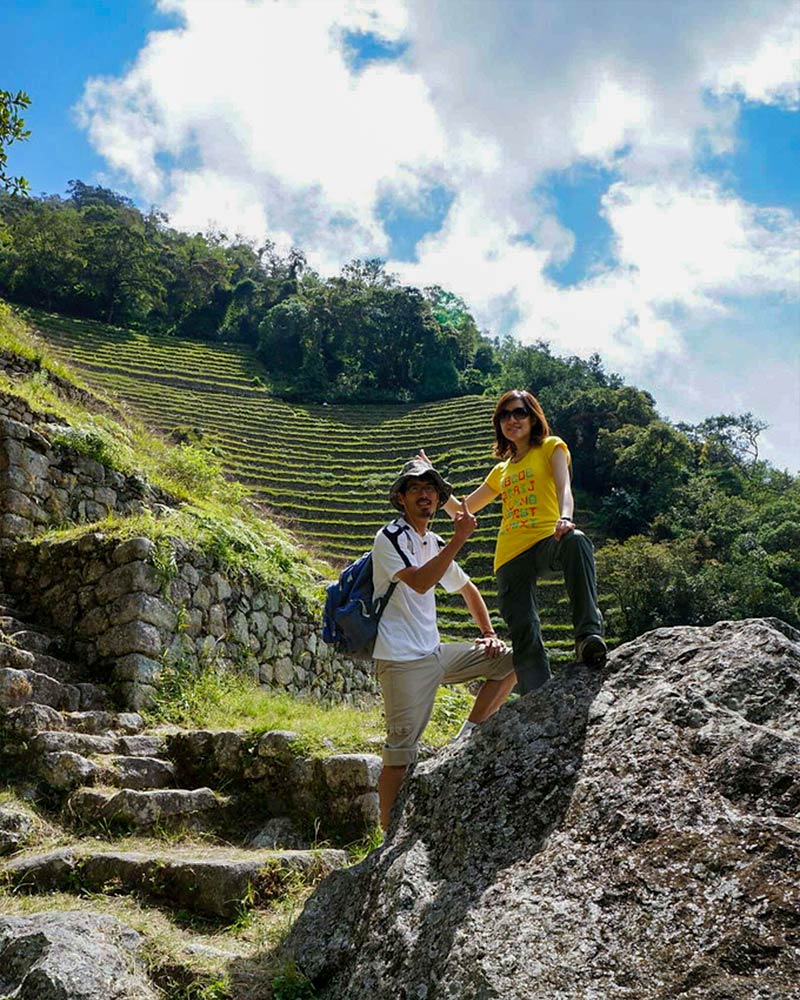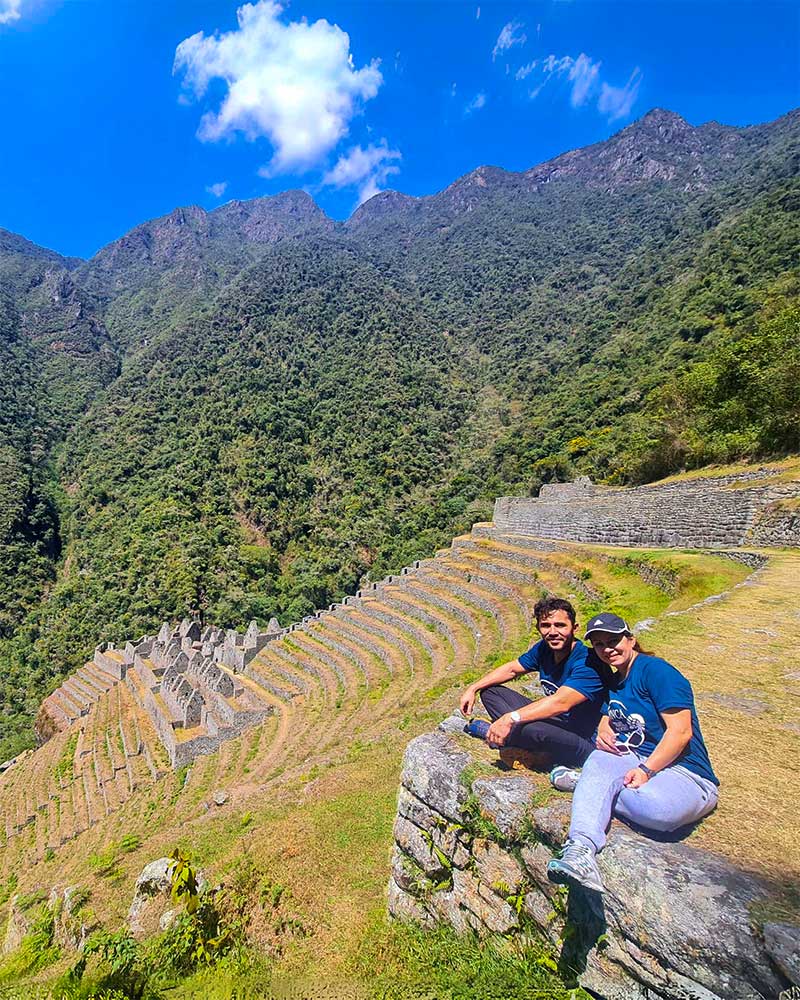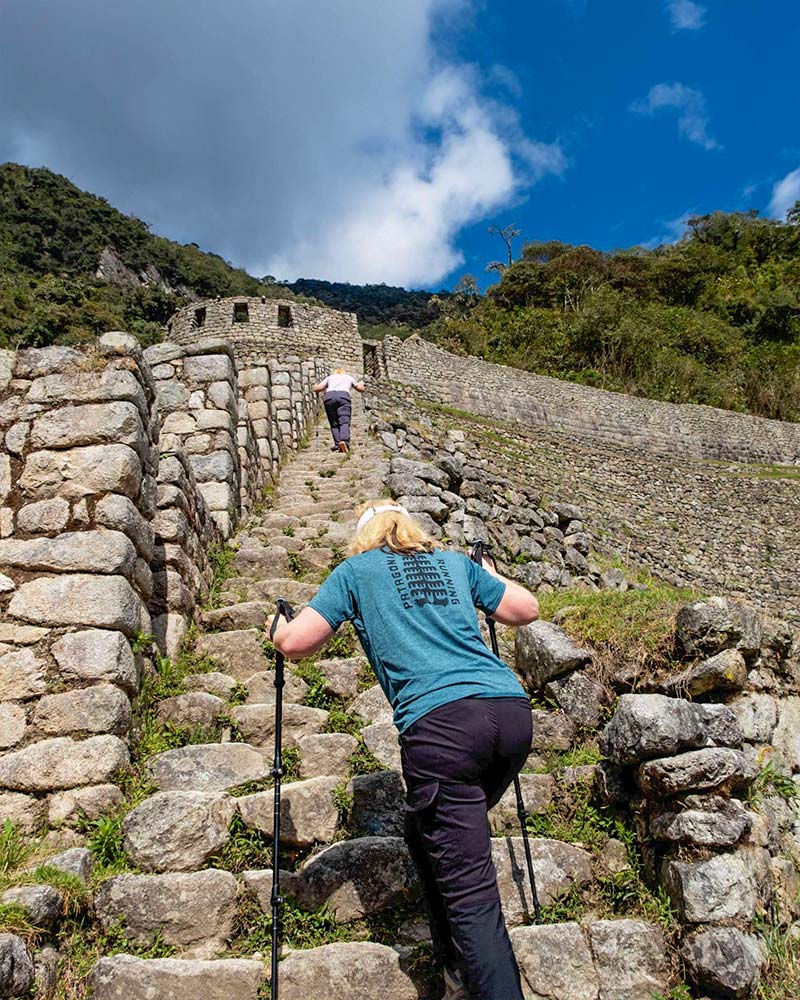
Wiñay Wayna, a Quechua name that translates as "Forever Young", is one of the most spectacular and best-preserved archaeological sites along the Inca Trail to Machu Picchu. Located strategically on a mountainside at 2,700 masl, it overlooks the Urubamba River canyon and represents the last great Inca construction before reaching the Inti Punku (Sun Gate), the entrance to Machu Picchu.
The complex, discovered in the 1940s by the Paul Fejos expedition, is a notable example of Inca engineering adapted to vertical terrain. Its design is divided into an agricultural sector, made up of an impressive set of andenes (terraces), and an urban sector with housing complexes in the upper and lower parts, both connected by a long stairway flanked by a series of ritual fountains.
For hikers on the Classic Inca Trail, Winay Wayna is not just a site to visit, but it also gives its name to the last campsite before the final day. Its architecture, combined with its location in the dense cloud forest, offers one of the most impressive Peru Landscapes in the entire sanctuary.
It is an archaeological site belonging to the Inca period, built by the Inca Pachacutec, the maximum representative of the Inca Culture, known as the architect of the Inca period. The name corresponds to an orchid that abounds in the place.
The Winay Wayna ruins in Perú date back to the mid-15th century, built during the days of the mighty Inca Empire. They are one of the stops along the Inca Trail, and the exact purpose of the site is difficult to say. It may have been a spiritual or religious destination, or simply a place for elders or royalty to rest before reaching the end of the 26-mile journey to Machu Picchu.
The Winay Wayna ruins in Perú consist of upper and lower collections of Inca architecture, connected by stone steps that appear in elegant curves. The upper structures have a unique circular building, while below is a collection of linear parapets with sharp peaks, jagged walls, and huge stone slabs with little space between them. The precarious staircase between the two levels embraces a long line of ancient fountains, often called baths.
In addition to the architectural structures, the area is surrounded by an agricultural complex, terraced with extraordinary masonry of local stones.
 |  |  |
Winay Wayna ruins in Perú is completely conditioned so that you can spend the night peacefully, it is also quite safe, it has more than 125 square meters of retaining walls.
Winay Wayna ruins in Perú has a wonderful architectural, agricultural and religious design. To begin with, it is evident that he follows the Inca worldview of adapting construction to the natural environment: Wiñayhuayna is perfectly attached to the side of a mountain, a really interesting way of building. This is so because the Andes of Cusco do not offer much flat soil for cultivation, so the Incas had to modify the mountainsides to prepare them for agricultural activities. The site shows a large number of terraces that were used for agriculture, mainly potatoes, corn and coca. As was the rule in Inca economic organization, the complex also has administrative areas, one at the top of the site and one at the bottom, which were interconnected by a stone staircase. In these offices, Inca officials planned and controlled all agricultural production, guided by the sun, the moon and the rain, which marked the seasons; For example, the harvest time was at the beginning of August, on today's calendar, because days later the coldest part of the year arrives in the region.
The architecture is of the same type as in Machu Picchu. The buildings are built with lithic granite elements. The main cover is double jamb and the others are single jamb. As is characteristic of Inca architecture, the covers, windows and niches are trapezoidal in shape; while the roof structures were supported by steep gables, supported by grips and rings.
Wiñayhuayna's andenería system is special for having managed to gain completely difficult territories for cultivation, there are also a series of enclosures used as permanent residences
This is the last archaeological site, before entering the Sanctuary of Machu Picchu and it is visited once the last camping site Wiñayhuayna is reached. The origin of its name is due to the Epiderdrum (Wiñayhuayna) orchid in large quantities in its surroundings. Huayna Picchu is built in the high jungle and the difference compared to the other archaeological remains is that in this place you can see great biodiversity, both flora and fauna.
They kept an accurate count of production using quipus, a statistical system that was made into long chains that were knotted and tied precisely to provide accurate information on agricultural resources.
Finally, there were department stores called qolqas, the places where the crops were placed.
Wiñayhuayna has some of the most special buildings you can see on the Inca Trail, showing the great building skills and deep spiritual feelings of the Inca culture. Among its most important structures are:
Winay Wayna to Machu Picchu route shows incredible architectural beauty and majesty, and also really interesting historical and cultural information, but this is not all. It is located in the middle of the most wonderful landscapes of huge green mountains, the Urubamba river and the exuberant vegetation, and where you can also find free animals only Andean like the famous llama and the Andean eagle, the condor. It is a place full of the strong flow of energy of the Andean nature, in a clean, healthy and relaxing environment. Without a doubt, it is one of the highlights of the Classic Inca Trail and the Short Inca Trail.
Other ways to get to Machu Picchu besides cheap inca trail tours include the 3 Day Inca Trail, 2 day Inca Trail with camping.
Winayhuayna is one of the most amazing old places on the Inca Trail, not just for its old history, but also for the many different plants around it. Near it, visitors can see a lot of different plants, like ferns, pepper trees, cedars, carnations, and eucalyptus trees. But, the most common plant in the area is the orchid, a very beautiful flower that makes the area look nice with its bright colors and special shapes.
The Machu Picchu Historic Sanctuary has about 300 kinds of orchids, which makes it a great place for people who love plants. Among them, the 'Winayhuayna' orchid stands out, known for its bright purple color. It is so important that, in 1942, the Peruvian archaeologist who explored the area decided to name this old place after the flower: Winay Wayna, which in Quechua means "forever young". This name shows not only the lasting beauty of the orchid, but also the greatness of this well-known place on the Inca Trail.
According to many guides, the trip lasted around 3 days, following the Inca Trail tours, it started in the community of Piscacucho, although there are other ways to get from Winay Wayna to Machu Picchu, depending on the routes the tourist takes, you can see beautiful communities like Cusichaca (km 82), Huayllabamba (km 88) Chachabamba (km 104).
The Wiñaywayna ruins are a stop along the Inca Trail, just 3 miles (4.7 km) from Machu Picchu. They are a short walk from the camps and are accessible between 8 a.m. and 8 p.m.
The Inca Trail to the Winay Wayna campsite is like a walk through time. Something about it feels eternal. Named for the delicate orchids that dot the landscape, the name means "ever young" in the native Andean language of Quechua, a name perfectly suited to such an eternal site.
Winay Wayna campsite is located in a cloud forest, with mist going in and out, lush dark green on the steep slopes of the mountains, and a constant waterfall casually lying in the distance. Despite the beauty of the surroundings, it is almost always devoid of tourists, with the occasional Inca Trail campers the only people in sight.
Peru offers fascinating experiences that reveal natural landscapes, historical monuments, and living cultures, captivating those who seek adventure and discovery in every corner of its territory. Get to know the most outstanding tours:
Other trips in Peru
If you want to visit Machu Picchu, we recommend you to book your Machu Picchu Entrance Tickets in advance, so you will enjoy your Vacation in Machu Picchu without any problem.